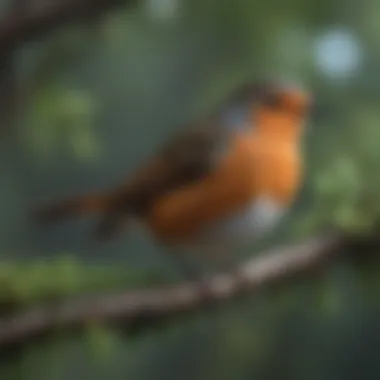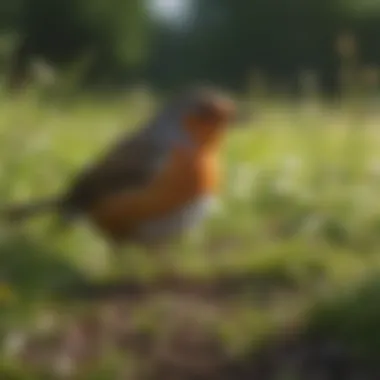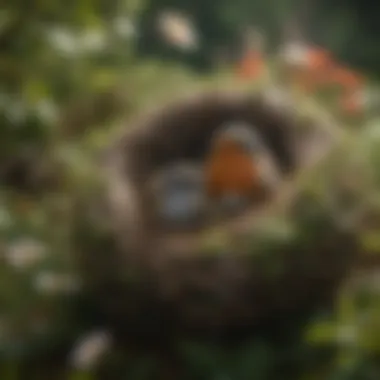Unveiling the Enigmatic World of Robins: A Dive into Their Unique Traits and Ecosystem Role


Nature Topic Overview
Robins, the charming birds with their vibrant red breasts and melodious songs, are a fascinating subject of exploration. These intriguing creatures inhabit various ecosystems, bringing joy and wonder to nature enthusiasts of all ages.
Fun Facts and Trivia
Young readers will be delighted to learn that robins are not only beautiful but also resourceful creatures. Did you know that robins can lay up to three broods of eggs a year, showing their dedication to propagation? Moreover, their distinctive orange-red breast is more vivid in males, serving as a visual spectacle in the avian world.
Wildlife Explorations
Delve deeper into the realm of robins and discover their close relatives, such as the Rufous-backed Robin or the American Robin. These species showcase a range of adaptations to diverse habitats, from forests to urban areas. Challenge your knowledge with interactive quizzes focused on identifying different robin species based on their unique features.
Environmental Awareness
Understanding the ecological importance of robins is crucial for promoting conservation efforts. By learning about how robins contribute to seed dispersal and insect control, children can appreciate the role these birds play in maintaining ecosystem balance. Discover practical tips on building bird-friendly habitats in your backyard to support robin populations.
DIY Nature Activities
Encourage hands-on engagement with nature through fun activities inspired by robins. Create a bird feeder using simple materials found at home, attracting these feathered friends to your outdoor space. Additionally, embark on bird-watching expeditions to observe robins in their natural habitat, fostering a deeper connection with the avian world.
Introduction to Robins
Robins, often revered for their symbolic beauty and grace, stand as iconic creatures in the avian world. This section unravels the essence of robins, shedding light on their unique characteristics, habitats, behaviors, and ecological significance. From their striking red breast to their melodious songs, robins captivate nature enthusiasts of all ages. Venturing into the world of robins opens a window to the wonders of nature, inviting readers to explore the intricacies of these enchanting birds.
Robins: A Symbol of Beauty and Grace
The Red-Breasted Beauty
Robins are distinguished by their vibrant red breast, a striking feature that sets them apart in the avian realm. This bright splash of color not only adds to their charm but also plays a significant role in their identity. The red-breasted beauty of robins symbolizes vitality and endurance, reflecting their robust nature and adaptability. This characteristic serves as a beacon of inspiration for many, resonating with the allure of the natural world. It is this vibrant hue that makes robins a popular subject of admiration and study. Despite its eye-catching appeal, the red breast camouflages well amid greenery, offering a blend of beauty and functionality.
Symbolism in Different Cultures
The symbolism of robins in different cultures further enhances their mystique and allure. Across various traditions and mythologies, robins hold diverse symbolic meanings, ranging from joy and renewal to protection and guidance. In some cultures, robins are believed to bring good luck and prosperity, while in others, they are revered as messengers of hope and resilience. This symbolism intertwines with the universal appeal of robins, making them not just birds of beauty but also carriers of profound messages that resonate with humanity's collective consciousness.


Habitat and Distribution
Preferred Habitats
Robins are known to prefer lush, temperate habitats with ample vegetation and open spaces. Woodlands, gardens, parks, and meadows are among their favored locations, providing an abundance of food and shelter. The choice of these habitats reflects robins' adaptable nature and their ability to thrive in diverse environments. Their presence in such habitats signifies a harmonious coexistence with natural surroundings, inviting admiration for their resilience and flexibility.
Global Distribution
Robins boast a wide global distribution spanning across continents, with various species inhabiting regions from North America to Europe and Asia. This widespread presence underscores the adaptability and resilience of robins as a species. By exploring their global distribution, one can elucidate the intricate patterns of migration, breeding, and territorial behavior that shape the geographic landscape of robins worldwide.
Physical Characteristics
Distinctive Features
One of the most notable features of robins is their compact size and round shape, coupled with a sharp, pointed beak ideal for capturing prey. Their keen eyesight and quick reflexes make them adept hunters, showcasing their remarkable survival skills. Additionally, robins exhibit a graceful demeanor in their movements, emphasizing a blend of elegance and efficiency in their actions.
Feather Coloration
The feather coloration of robins is a harmonious blend of earthy tones, with shades of brown, gray, and white complementing the vibrant red breast. This combination of colors not only aids in camouflage but also adds a touch of elegance to their appearance. The intricate patterns and textures of their plumage reflect nature's artistry, embodying a visual symphony that captivates observers.
Behavioral Insights
When delving into the captivating world of robins, exploring their behavioral insights unveils a treasure trove of information that sheds light on their survival strategies and interactions in their habitat. Understanding the behavior of robins is crucial for appreciating their adaptability and evolutionary success. From feeding habits to breeding patterns and migratory behavior, each aspect of their behavior provides valuable insights into their ecological niche.
Feeding Habits
Robins exhibit a diverse range of feeding habits, reflecting their omnivorous nature. Their dietary preferences play a significant role in shaping their foraging behavior and overall health. Dietary preferences encompass a wide array of foods, including insects, fruits, and berries. This varied diet ensures that robins obtain essential nutrients vital for their wellbeing and reproductive success. Their ability to adapt their diet based on seasonal availability showcases their resourcefulness in securing sustenance.
Dietary Preferences
The dietary preference of robins for fruits and insects is a pivotal aspect of their feeding habits. These preferences highlight their role as seed dispersers in various ecosystems. By consuming fruits and dispersing seeds, robins contribute to the propagation and diversity of plant species. This mutualistic relationship between robins and plants emphasizes the ecological significance of their dietary choices.
Foraging Techniques
Robins employ an array of foraging techniques to acquire food efficiently. From probing the soil for insects to plucking berries from shrubs, their foraging methods are diverse and adaptable. Their keen eyesight and agile movements aid in locating and capturing prey swiftly. By employing behavioral cues and environmental cues, robins optimize their foraging efficiency and reduce energy expenditure, ensuring their survival in dynamic habitats.


Breeding Patterns
The breeding patterns of robins offer a glimpse into their reproductive strategies and parental care. Nesting behaviors and reproductive cycles are integral components of their breeding patterns, shaping the population dynamics of robins across different regions.
Nesting Behaviors
Robins exhibit intricate nesting behaviors, constructing nests with meticulous care and attention to detail. The selection of nest sites, nest building materials, and nest maintenance behaviors reflect the dedication of robins towards ensuring the safety and comfort of their offspring. Their nest architecture showcases their adaptive strategies in response to environmental challenges, safeguarding their young from predators and inclement weather.
Reproductive Cycles
The reproductive cycles of robins are finely tuned to environmental cues and seasonal variations. From courtship rituals to egg-laying and incubation, each stage of the reproductive cycle is vital for successful breeding. Robins synchronize their reproductive efforts with food availability and climatic conditions, maximizing the chances of offspring survival. By exhibiting strategic timing in their reproductive cycles, robins enhance their reproductive success and maintain population stability.
Migratory Behavior
The migratory behavior of robins exemplifies their remarkable navigational skills and endurance during long-distance journeys. Seasonal movements and migration routes are critical aspects of their migratory behavior, highlighting the adaptive advantages of their migratory strategy.
Seasonal Movements
Robins undertake seasonal movements in response to changing environmental conditions and food availability. Their ability to adjust their range and distribution based on seasonal fluctuations ensures their survival across diverse habitats. Seasonal movements also play a key role in shaping the genetic diversity and population dynamics of robins, fostering resilience in the face of environmental challenges.
Migration Routes
The migration routes of robins span vast distances, with some populations traversing thousands of miles to reach their wintering grounds. These migration routes are ingrained in their genetic heritage, passed down through generations to guide their annual journeys. By following specific migration routes, robins optimize their energy expenditure and minimize risks associated with long-distance travel. The inherent navigation abilities of robins enable them to navigate complex landscapes and navigate obstacles efficiently, showcasing their remarkable migratory prowess.
Ecological Significance
In this segment of the article on Robin exploration, we delve into the crucial Ecological Significance aspect, shedding light on why understanding the role of these birds in the ecosystem is paramount. Robins play a vital part in maintaining the environmental balance due to their contribution to seed dispersal and predator-prey dynamics, making them a linchpin species in various habitats around the world. By examining their interactions with the environment, we can appreciate how these small creatures have a significant impact on biodiversity and ecosystem health.
Role in Ecosystem
Seed Dispersal
The process of seed dispersal amounts to a fundamental ecological service provided by robins. Through ingesting fruits and seeds, robins unintentionally aid in the dispersion of plant seeds across different areas as they move around. This action promotes plant diversity by enabling seed germination in new locations, thereby playing a crucial role in sustaining plant populations. Despite the inadvertent nature of this process, seed dispersal by robins stands as a vital mechanism for maintaining ecosystem resilience and assisting in plant reproduction and distribution.


Predator-Prey Dynamics
Exploring the predator-prey dynamics involving robins unveils their dual role as both predators and prey in the ecosystem. By consuming insects and small invertebrates, robins help control populations of potential pests, contributing to the overall balance of their habitats. Simultaneously, they serve as prey to larger birds and mammals, forming an integral part of the intricate food web. This interaction highlights the interconnectedness of species in the ecosystem, showcasing how robins' presence influences the regulation of predator-prey relationships and ultimately shapes the biodiversity of their surroundings.
Interactions with Humans
Diving into the interaction between robins and humans illuminates the cultural significance and mutual impact of these encounters. Through cultural depictions, robins have been revered in various traditions and folklore, symbolizing different virtues and bringing about artistic inspirations. This cultural symbolism enriches human society, connecting people with nature in profound ways and highlighting the timeless allure of these birds.
Cultural Depictions
Robins feature prominently in literature, art, and myths across different cultures, symbolizing themes such as renewal, hope, and transformation. Their presence in human narratives reflects a deep-rooted admiration for their beauty and resilience, enhancing the cultural tapestry with their symbolic meanings and metaphorical representations.
Garden Visitors
As frequent visitors to gardens and urban spaces, robins bring joy and curiosity to human observers. Their inquisitive nature and melodious songs enchant individuals of all ages, fostering a sense of connection with the natural world. Encountering robins in garden settings provides a glimpse into their daily lives, promoting appreciation for biodiversity and nurturing a harmonious relationship between humans and wildlife.
Conservation Efforts
In this section, we delve into the crucial topic of Conservation Efforts regarding the fascinating world of robins. Conservation plays a pivotal role in safeguarding the delicate balance of ecosystems where robins thrive. By focusing on ethical practices and sustainable measures, conservationists aim to protect the habitats and well-being of these remarkable avian species. The preservation of robins not only ensures their survival but also contributes to the overall biodiversity of our planet.
Threats to Robin Populations
Habitat Loss
The menace of Habitat Loss poses a significant threat to robin populations worldwide. Urbanization, deforestation, and agricultural expansion are primary culprits behind the diminishing habitats of these iconic birds. When natural habitats are destroyed or altered, robins face challenges in finding suitable nesting sites and food sources. This disruption in their ecosystem can lead to a decline in population numbers, impacting the delicate balance of nature. Conservation efforts focus on mitigating habitat loss through land preservation, restoration projects, and creating protected areas to secure robin habitats.
Climate Change Impact
Climate Change Impact is another pressing issue impacting robin populations. Changes in temperature patterns, extreme weather events, and shifting climatic conditions can disrupt the natural behaviors and migration patterns of robins. These environmental shifts pose challenges for robins to adapt and thrive in their habitats. Conservation strategies emphasize studying the effects of climate change on robins and implementing measures to mitigate its adverse impact. By raising awareness about climate change issues and advocating for sustainable practices, conservationists strive to safeguard robins from the detrimental effects of a changing climate.
Conservation Initiatives
In the realm of Conservation Initiatives, various strategies are employed to protect and sustain the populations of robins across the globe. These initiatives encompass a range of actions aimed at ensuring the long-term survival of these captivating birds.
Protective Measures
Protective Measures entail a set of actions designed to shield robins from threats such as predation, habitat loss, and human disturbances. Nest box programs, predator control measures, and habitat restoration projects are essential components of protective measures. These endeavors create safe havens for robins to breed, feed, and thrive, contributing to their conservation and well-being.
Community Involvement
Community Involvement is a key aspect of conservation initiatives, fostering a sense of stewardship and responsibility among local communities towards robin populations. Engaging the public in citizen science projects, educational outreach programs, and habitat restoration efforts not only raises awareness about the importance of conserving robins but also instills a sense of environmental consciousness. By involving communities in conservation efforts, a collective impact can be made towards safeguarding robins and their habitats for future generations.







